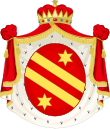Prince Canino Line
| Prince of Canino and Musignano | |
|---|---|
 |
|
| Parent house | House of Bonaparte |
| Titles | Prince of Canino Prince of Musignano |
| Founded | 1814 |
| Founder | Lucien Bonaparte |
The Princes of Canino and Musignano formed the genealogically senior line of the Bonaparte family following the death of Joseph Bonaparte in 1844. The line was founded by one of Emperor Napoleon's younger brothers, Lucien Bonaparte. It became extinct in the male line in 1924. The dynastic Bonapartist pretenders descend in the male line from Prince Jérôme Napoléon, Napoleon's youngest brother.
Canino and Musignano are two neighbouring villages in the Province of Viterbo in Italy. The titles were bestowed on Lucien Bonaparte by papal authority on 18 August 1814 (Prince of Canino) and on 21 March 1824 (Prince of Musignano).
Article 7 of the monarchical constitution of the First French Empire, promulgated 20 May 1804, established that upon extinction of the legitimate natural and adopted male, agnatic descendants of Napoleon I (1769–1821), and those of two of his brothers, Prince Joseph Napoléon (1768–1844) and Prince Louis Napoléon (1775–1846), the throne was to be awarded to a man selected by the non-dynastic princely and ducal dignitaries of the empire, as ratified by plebiscite. On 24 September 1806, the emperor's youngest brother, Jérôme Napoléon (1784–1860), was made a French prince, along with the future issue of his second marriage to Duchess Catharina of Württemberg, and he and his heirs were added into the succession.
On 22 March 1815, during the Hundred Days, Napoleon also recognized his brother Lucien and Lucien's sons as Imperial French princes. At no time, however, were Lucien and his issue recognized during the First Empire as eligible by law to inherit the French throne, or any other throne. The title of Principe di Canino e Musignano borne by Lucien and his heirs male was a papal title of nobility, never legally recognized in France.
...
Wikipedia
